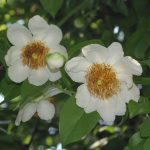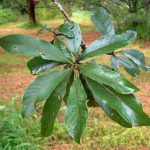TREE LIFE
JANUARY 1989
MASHONALAND CALENDAR
Sunday 25th Decmber 1988: Happy Christmas
Sunday 1st January, 1989: Happy New Year
Tuesday 3rd January : Botanic Garden Walk. Meet in the Car Park at 1645 hours for 1700 hours.
Sunday 15th January : TRIANDRA, THE FEET FARM. Our January outing promises to be another exciting trip to the farm of Alan and Helen Foot. We may remember that this is where Edna Petheram first discovered Ochna gambleoides. We revisited these same trees a few years ago in September when the lannea were in full flower. We hope to find a new population in a different woodland along with Dalbergia nitidula and Uapaca nitida. We will travel in our own cars/bikes as it is not too far. Meet at the house at 0945 hours for a quick cup of tea and buns. Contact a Committee member if you need a lift.
Saturday 28th January : Mukuvisi Woodland meeting at 1500 hours. Meet at the Paget Road/Inyanga Crescent gate.
MATABELELAND CALENDAR
There will be no January outing, but we are kindly invited on Monday, January 2nd, to Norma Hughs’ house, 10 Garryowen Way, Riverside, off Brentwood Road, for a picnic lunch. Come about 1200 hours and bring a plate of eats, your own refreshment and chairs.
MATABELELAND NOTES
On Sunday December 4th we went to the Matopos, more to the south than we usually go, to the Singing Rocks. There we all bashed various rocks, several of which were very musical. The drive in and the trees were most rewarding. We identified some 83 species, there, and near Bambata Cave Area, where we lunched, but had to leave with the onset of rain. On the way in we passed Acacia tortilis. We later saw many Afzelia quanzensis, Pod Mahogany with large empty pods, Albizia tanganyicensis, A. versicolor with much fruit, Allophylus africana, Artabotrys brachypetalus, Azanza garckeana, Bauhinia galpinii, Brachylaena rotundata, Cassia abbreviata with pods over 60cm, Clerodendrum myricoides,
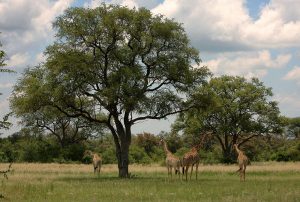
Combretum imberbe. Poto: Mark Hyde. Source: Flora of Zimbabwe.
Combretum imberbe, C. molle, Crossopteryx febrifuga, Cussonia natalensis, Diospyros mespiliformis many Diplorhynchus condylocarpon, Elephantorrhiza goetzei with huge pods, Entandrophragma caudatum, Euphorbia cooperi, E. griseola, Faurea saligna, Ficus sur, F. tettensis, Gardenia volkensii, Grewia monticola in flower, Heteropyxis dehniae, the lavender tree, Hexalobus monopetalus, baboon’s breakfast, which certainly puzzled me at first, Kirkia acuminata, Mimusops zeyheri, Ochna glauca, with its blue tinged leaves, Pavetta schumanniana showing its dark bacterial ‘dots’, Peltophorum africanum in full flower, Psiadia punctulata, shiny and sticky looking, Pterocarpus angolensis, mukwa, with large green fruit, Schrebera alata, Sterculia rogersii, unexpected not on our field card even, but we were in no doubt, Strychnos matopensis, S. madagascariensis,, Tarenna neurophylla, Turraea obtusifolia, Vitex payos, Zanthoxylum capense.
C. Sykes.
BOTANIC GARDEN WALK :5TH DECEMBER AND 6th DECEMBER 1988
We have looked at the Citrus family, RUTACEAE, before but that was four years ago and I have been trying to put together a simple “Identify the RUTACEAE all by myself guide” particularly for the ones with three leaflets and have failed miserably. So, at my request, the Botanic Garden Walks on October and December were devoted to the study of RUTACEAE. Tom certainly made it all seem so simple. As the species grow in a variety of ecological habitats and the gardens are laid out in ecological areas, we had to do a fair amount of brisk walking and we still did not have time to look at all the species.
The following is a combination of Tom’s words of wisdom and my researches.
The best known members are, of course, the oranges and lemons Citrus aurantium and Citrus limon respectively both of which have become naturalised in the country. The other members of the family share the characteristics of having leaves with citrus oil glands. When a leaf is held up to the light these are visible as pellucid or transparent gland dots, either all over the leaf surface, or round the margins. They are also responsible for the strong citrus scent when a leaf is crushed. If you are not quite sure what a pellucid gland dot looks like, have a look at the leaf of a citrus tree, preferably through a lens or magnifying glass. Leaves of the family ANNONACEAE also contain citrus oils and have pellucid gland dots, but they have simple leaves, alternate, in two rows on opposite sides of the branch. Some species are armed with prickles or spines and the fruit often looks like miniature version of the cultivated citrus fruit.
-Meg Coates Palgrave
NYAZENGU NATURE RESERVE, INYANGA, GUEST OF CRISPIAN AND ELIZABETH TRACE
Zhizha (the rainy season) arrived and we headed off to Nyazengu on the slopes of Inyangani. If you think Harare can be wet, Nyazengu frequently receives over 5 metres of rain in a single year. We prepared for a wet weekend. The Trace’s arrived at Inyangani Car Park to meet us and chauffeur us to Nyazengu in their Landrover. Meg left Genie alongside the road but Phil decided to venture onwards with Big Blue. The Mutare contingent were investigating a deep ditch with one wheel of their little red Renault and so missed the Landrover but made it later on on their own. It is a fine tribute to the Traces road building technique that we all arrived undamaged. Nyazengu ranges in height from the beacon at Inyangani (2539) to the Nyaengu River just below 1400m, a total range of almost 1200m. The Traces’ and John Turnbull Kemp have constructed a comfortable cottage with warm coal stove, shower and a long drop with a view of the forest. Having wolfed down lunch with various liquid refreshments we set off into the forests, while Chris went to rescue a party of over-landers.
I would have described the forest as Afro-montane forest. There are a number of elements in it that occur together from the slopes of Mt Kilimanjaro to the forests around Tsitsikamma and Table Mountain. As the latitude increased so the altitude at which these trees occur decreases. Here they grew at 2000m, in Cape Town they grow just above sea level. The association in question includes Ilex mitis, Curtisia dentate, Halleria lucida, Podocarpus latifolius, Rapanea melanophloes, Carissa bispinosa (although a different sub species), Diospyros whyteana, Rhamnus prinoides and Heteromorpha trifoliata. But Tom, who has spent many hours studying these Eastern Highlands forests found this school book outlook a bit simplistic. Individual species each have their own range and these associations are not as neatly tied to one another submontane or lowland forests. Of the montane forests a dry montane forest is one containing Widdringtonia, Ilex, Scheflera, Curtisia, Rapanes and possibly Macaranga. These forests would then be dry montane forest, although with a rainfall of over 3m a year who wants to live in a wet forest? Reflecting on many of Tom’s botanic garden walks we have seen how often Tom refers to altitude, and this is definitely an important factor. These are 2000m forests of Inyangani.
There are three forests relatively close to the cottage and each has a different atmosphere. All are gulley forests associated with streams. They are surrounded by “grasslands” or open heath lands which are subjected to occasional burning. Fires on these heath lands probably control the size and age of these forests. Each forest has a forest edge consisting of shrubs and pioneer species. It is often difficult to penetrate this fringe but once inside the under storey is relatively undeveloped. The first forest edge contained Clausena anisata, Halleria lucida and Hypericum. The second edge had
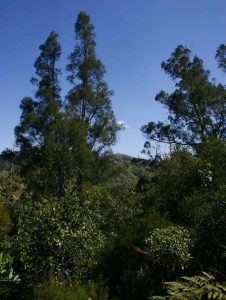
Widdringtonia nodiflora. Photo: Bart Wursten. Source: Flora of Zimbabwe
Widdringtonia nodiflora and Passerina montana, where in the third edge we battled through Rubus. The centre of the forest is densely shaded and open with little ground cover. The poorly developed under storey contains saplings of the more mature trees as well as Peddia africana and Psycotria zambamontana. The family to which Peddia belongs (THYMELIACEAE) is characterised by having a fibrous bark that strips off in long heels. The flowers have a green tube but this is not formed by the petals and there are not any. I still find these broad-leaved members of this family (like Peddia and Dias) peculiar as in the Cape members generally have narrow ericoid leaves. These were illustrated in the Passerina montana. We struggled to identify Psychotria zambamontana although it was obviously a RUBIACEAE. Apparently the leaves may have bacterial nodules like Pavetta or other Psychotria, but we did not notice these (or did not look). Although we had leaves, flowers and fruit we failed to key it out. The key features included small flowers in branched, but not tightly spherical, heads. The fleshy fruit should be ovoid. The flower heads we found were both terminal and axillary, but apparently they are meant to be terminal. The flower buds (not the leaf buds) are not long and narrow and the fruit is conspicuously ribbed (I do not remember this feature). Along the river of the first forest the under storey was dominated by Rhamnus prinoides and Choristylis rhamnoides. I find these two most remarkable. They belong to two different families in two different orders. Choristylis belongs to the GROSSULARIACEAE (Cronquist, 1988, this family includes the old Iteaceae) in the order Rosales. Rhamnus belongs to the RHAMNACEAE in an adjacent order Rhamnoles. And yet their growth is so similar that the leaves are almost identical Choristylis is more of a climber with longer trailing branches. The leaves tend to be broader towards the base and appear “pinched”, often with distinct pockets in the axils of the veins. This condition in which two unrelated species that grow in a similar habitat and have a similar structure is known as convergent evolution. The canopy trees in the first forest included Curtisia dentata, enormous Heteromorpha trifoliate, Schefflera umbellifera, Xymalos monospora, Rapanea melanophloeos and Ilex mitis. The fruit of Diospyros whyteana littered the ground but unfortunately for the seed gatherers all the bladders were empty. The tree-fern Cyathea dregei was also present. In the second forest we discovered Afrocrania volkensii, a tall tree with pale foliage and layered branches that are easily spotted when looking down on the forest canopy from the surrounding hills. This forest had a more diverse and open canopy with more light and greater diversity in the under storey. Piper capense displayed its arthritic elbows. Swynnerton used the fruit of this to favour stock, it may be important in view of the shortages in Zimbabwe. Aphloia theiformis showed its zig zag branches and finely serrated leaves. The great excitement was the discovery of Cyathea capensis. I have not seen this in the wild before although Tom had one that was killed by too many salts in the borehole water which sprayed on its fronds. In contrast to C. dregei the stems are slender and they have finely branched filamentous growths at the base of each frond. These aphlebia are green but dry to brown and become incorporated into the stem. Apparently the spiny tree-fern, C. manniana also grows nearby forming impressive forests on parched water tables between Inyangani and the Honde Valley tea estates. The path back from the C. capensis to the cottage led through fields of wild flowers, a startlingly attractive display on recently burned heathlands.
Many of the botanical highlights in the third forest were eclipsed when Jessica and Phil found a forest dwarf chameleon, a new sight for many of us. Its tail is shorter and less prehensile than the common chameleon and its head is more square with a sharply pointed nose, the back of the head is also more shield like and does not form a raised crest.. Meg photographed this funny little fellow and may have snapped him snapping a fly. A second herpetological highlight was our almost standing on a berg adder in the long grass.
Once we have had all the herbarium material identified we will produce a more complete tree list. The highlight of Sunday was a walk along the Nyazengu River to a clear pool beneath a long cascading waterfall. Here beneath a Strelitzia nicolai and
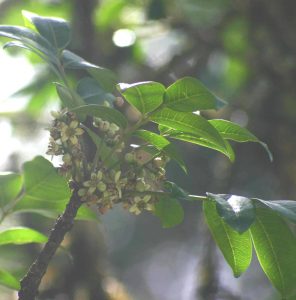
Ekebergia capensis. Photo: Bart Wursten. Source: Flora of Zimbabwe
Ekebergia capensis we swam in the sunshine. I must confess that at times the incredible beauty of an area, together with the pleasure of the company leads to botanical lethargy. At lunchtime this feeling of well being was accentuated by a feast of imported fish, mussels, olives and G & T. I can fully understand why all productivity ceases in Paradise. After lunch we drove to the heights of the western slopes of the Nyazengu and looked over at the forest on the far slopes. Although this looks like many acres of well developed virgin forest, this may not be so. We saw many Polyscias fulva and a few Anthocleista grandiflora. Both of these are forest pioneers that form a canopy in disturbed areas. Other species grow in their shade and eventually dominate the forest. Tom says there is much evidence that this area was cleared by previous civilizations and described a strange structure on the hill where the tributary which we swam at joins the single drop Nyazengu Falls. The map indicates that this entire slope has ancient terracing, which may not have been ancient but rather medieval. Further investigation, possibly with an archaeologist would be most fruitful. Another visit is definitely called for. Before we left, the heavens opened up and showed us how easy it is to accumulate a 5m rainfall. It is difficult to express our full thanks to the Traces, but I can assure them that they would have to look long and hard to find a more appreciative audience.
Kim Damstra.
FOOTNOTE
By popular request Benedicta Graves of Ayrshire Branch has kindly repeated her aide memoire verse for those who find that Acacia names stick less readily than their prickles.
Field Card Acacias
Erubs, Negres and Polys Galpin Goetz and Melliferous Schweins have PRICKLES.
Apart from Tortilis with both, all the rest have SPINES.
RECENT NAME CHANGES
Included in this newsletter is a list of recent name changes. The new names are in alphabetical order. (We assumed that when an unknown name is encountered that you will want to look it up). Updating your books can be done in reverse.
Acacia amythethophylla Acacia macrothyrsa
Acokanthera rotundata Acokanthera schimperi
Adenium multiflorum Adenium obesum
Afrosersalisia kassneri Tulestea kassneri
Aloe spicata Aloe sessiliflora
Bauhinia thonningii Piliostigma thonningii
Breonadia salicina Breonadia microcephala
Canthium oligocarpum Canthium captum
Cassipourea gossweileri Cassipourea sp. no 1
Cassipourea malosana Cassipourea congoensis
Catunaregam spinosa Xeromphis obovata
Chionanthus battiscombei Linociera battiscombei
Chionanthus foveolatus Linociera faveolata
Coddia rudis Xeromphis rudis
Combretum adenogonium Combretum fragrans
Combretum microphyllum Combretum paniculatum subsp. microphyllum
Commiphora glandulosa Commiphora pyracanthoides
Diospyros hoyleana Diospyros sp. No. 1
Dodonaea angustifolia Dodonaea viscosa
Dracaena usambarensis Dracaena reflexa
Erica evansii Philippia evansii
Erica simii Philippia simii
Euclea racemosa Euclea schimperi
Eugenia nyassensis Eugenia bukobensis
Ficus abutilifolia Ficus soldanella
Ficus bubu Ficus sp. no. 1
Ficus bussei Ficus zambesiaca
Ficus cordata Ficus salicifolia
Ficus glumosa Ficus sonderi
Ficus lutea Ficus vogelii
Ficus scassellatii Ficus kirkii
Ficus sur Ficus capensis
Ficus thonningii Ficus burkei/natalensis
Flueggea virosa Securinega virosa
Garcinia buchananii Garcinia huillensis
Gardenia ternifolia Gardenia jovis-tonantis
Gardenia volkensii Gardenia spatulifolia
Glenniea africana Crossonephelis africanus
Heinsenia diervilleoides Aulacocalyx diervilleoides
Heteromorpha trifoliate Heteromorpha arborescens
Heteropyxis dehniae Heteropyxis natalensis
Hyphaene petersiana Hyphaene benguellensis
Karomia tettensis Holmskioldia tettensis
Keetia gueinzii Canthium gueinzii
Keetia venosa Canthium venosum
Lannea schweinfurthii Lannea stuhlmannii
Maclura africana Cardiogyne Africana
Maranthes goetzeniana Maranthes polyandre
Margaritaria discoidea Phyllanthus discoideus
Markhamia zanzibarica Markhamia acuminate
Milicia excelsa Chlorophora excelsa
Mimusops obtusifolia Mimusops fruticosa
Necepsia castaneifolia Neopalissya castaneifolia
Obetia tenax Urera tenax
Ochna arborea Ochna oconnorii
Olea europaea Olea Africana
Oncinotis tenuiloba Oncinotis inandensis
Ozoroa insignis Ozoroa reticulate
Pavetta comostyla Pavetta angolensis
Pavetta gardeniifolia Pavetta assimilis
Phyllanthus ovalifolius Phyllanthus guineensis
Phyllanthus pinnatus Phyllanthus kirkianus
Pouzolzia mixta Pouzolzia hypoleuca
Protea caffra Protea gazensis
Psydrax livida Canthium huillense
Psydrax locuples Canthium locuples
Psydrax martini Canthium martini
Psydrax obovata Canthium obovatum
Psydrax parviflora Canthium vulgare
Pterocarpus lucens Pterocarpus antunesii
Pyrostria bibracteata Canthium bibracteatum
Rhus gueinzii Rhus natalensis
Rhus tumulicola Rhus culminum
Rytigynia macrura Rytigynia sp. no. 1
Salix mucronata Salix subserrata
Salvadora australis Salvadora angustifolia
Sclerocarya birrea Sclerocarya caffra
Senna petersiana Cassia petersiana
Senna singueana Cassia singueana
Sericanthe andongensis Neorosea andongensis
Solanecio mannii Crassocephalum mannii
Syzygium quineense sub. afromontanum Syzygium gerrardii
Tabernaemontana stapfiana Tabernaemontana africana
Tarenna littoralis Enterospermum littorale
Tarenna zimbabwensis Enterospermum rhodesiacum
Tarenna zygoon Zygoon graveolens
Tetradenia brevispicata Iboza brevispicata
Tetradenia riparia Iboza riparia
Tricalysia coriacea Tricalysia nyassae
Tricalysia jasminiflora Neorosea jasminiflora
Tricalysia junodii Tricalysia allenii
Tricalysia niamniamensis Tricalysia angolensis
Tricalysia pallens Tricalysia capensis
Tricalysia ruandensis Tricalysia congesta
Trilepisium madagascariense Bosqueia phoberos
Uapaca guineensis Uapaca sp. no. 1
Vernonia calvoana Vernonia hymenolepis
Vernonia exsertiflora Vernonia kreismannii
Vernonia myriantha Vernonia subuligera
Vitellariopsis ferruginea Vitellariopsis sylvestris
Zanthoxylum capense Fagara capensis
Zanthoxylum chalybeum Fagara chalybea
Zanthoxylum davyi Fagara davyi
Zanthoxylum gilleti Fagara macrophylla
Zanthoxylum leprieurii Fagara leprieurii
Zanthoxylum trijugum Fagara trijuga
DICK HICKS CHAIRMAN


